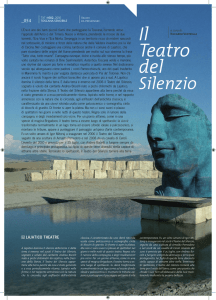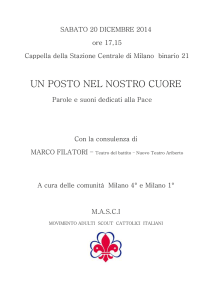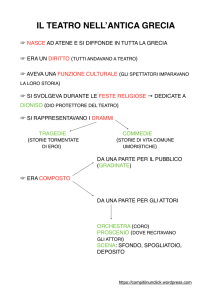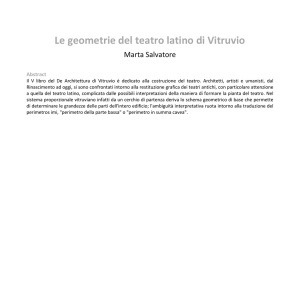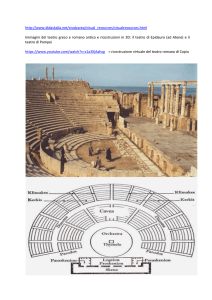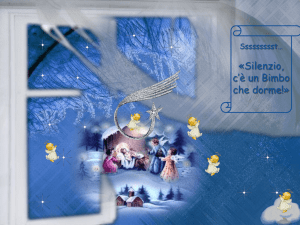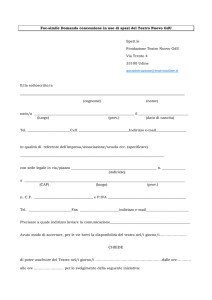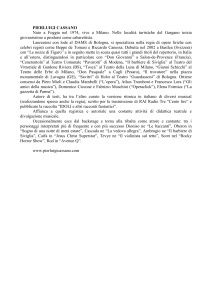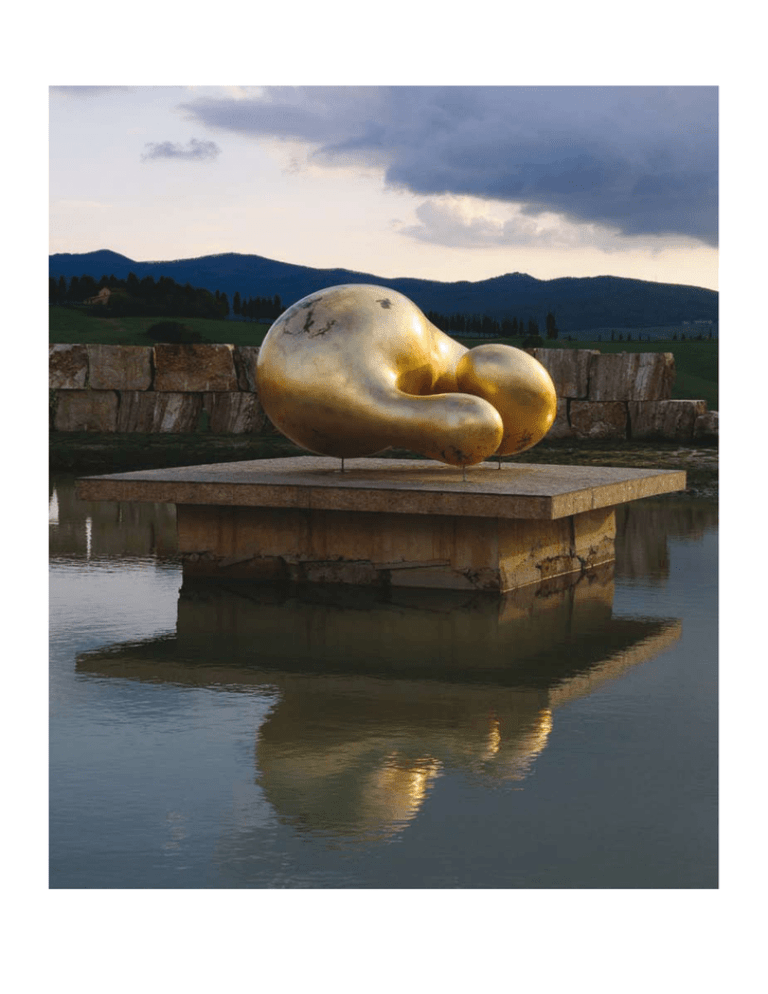
Un sasso
nello stagno
di/by
A pebble in the pond In its dictionary definition, silence is
abstention from speech or dialogue. But at the same time
silence may become "word" through Art in all its manifestations, which feeds on silence for its compositional inspiration. The "word" of silence is therefore not a pebble tossed in
a pond like a word in a story, but rather the concentric rings
which spread its meaning, its sound, its music. Indeed,
Miles Davis defines silence as "true music", because "all the
notes are just the frame for the silence". Likewise, in painting the "word" of silence can be expressed in all its dynamic,
fluid and invisible aspects: in the works of Piero della Francesca silence envelops the figures like a patina, transmitting
harmony and a sense of eternity through a skillful play on
colour; oriental etchings are composed in accordance with
the principles of silence. Thus silence opens chromatic and
acoustic horizons more that words themselves: "the word is
a key, but silence is a master key", according to Gesualdo
Bufalino. The Teatro del Silenzio makes this mental state
tangible through the lake that limits yet houses Art as the
new "word". The music performed at the Teatro is therefore
not its opposite, but its consequence, precisely because
sound strongly opposes silence but at the same time the
latter is the basis that underlies the former. With his 1952
performance 4’33’’, John Cage intuited the ambient value
of silence, its nature as the "word" within a story. In his
"non-piece" piece, the composition rests on the sounds of
the venue where the performance takes place, thus giving
importance to the environment itself. Similarly in the video
clip “Silence is sexy” by German group Einsturzende Neubauten, the sound of the cigarette being extinguished and
falling, as well as marking the time, defines the silence and
therefore the sound of it, its essence as a word. Music then,
through the voice of Bocelli, traces the shape of silence and
amplifies its meaning, its existence as word regardless.
Paolo Di Nardo
Il silenzio è astensione dalla parola o dal dialogo nella sua definizione enciclopedica. Ma allo stesso
tempo la sua espressione può diventare “parola” attraverso l’Arte, in tutte le sue manifestazioni, che
del silenzio si nutre come ispirazione compositiva. La “parola” del silenzio non è quindi il sasso gettato
in uno stagno come la parola in un racconto, bensì i cerchi concentrici che ne diffondono il senso, il
suono, la sua musica. Miles Davis definisce infatti il silenzio «la vera musica» perché «tutte le note
non fanno che incorniciare il silenzio». Allo stesso tempo nel contesto pittorico la “parola” del silenzio
si può esprimere nei suoi aspetti dinamici, mutevoli e invisibili: nei dipinti di Piero della Francesca il
silenzio avvolge come una patina i suoi personaggi comunicando armonia e senso di eternità attraverso
virtuosi giochi cromatici; le stampe orientali sono composte secondo i tratti compositivi del silenzio. Il
silenzio quindi apre orizzonti cromatici e sonori più della parola stessa: «la parola è una chiave, ma il
silenzio è un grimaldello» secondo Gesualdo Bufalino. Il Teatro del Silenzio materializza questo stato
mentale attraverso lo stagno che delimita ambientalmente, ma che accoglie al suo interno l’Arte come
nuova “parola”. La Musica che il Teatro accoglie non è quindi il suo opposto, ma la sua conseguenza
proprio perché il suono si oppone con forza al silenzio ma allo stesso tempo quest’ultimo è la base su
cui esso si stratifica. John Cage nel 1952 ha intuito attraverso la sua performance 4’33’’ il valore ambientale del silenzio, il suo essere “parola” di un racconto. Nel suo brano “non brano” la composizione
è disegnata dai suoni emessi dall’ambiente in cui viene eseguita dando così importanza all’ambiente
stesso in cui è eseguito. Allo stesso modo nel video clip “Silence is sexy” del gruppo tedesco Einsturzende Neubauten, il rumore della sigaretta che si spenge e cade, oltre a scandire il tempo definisce
il silenzio e quindi il suo suono, il suo essere parola. La musica, quindi, attraverso il canto di Bocelli
disegna i tratti del silenzio e ne amplifica il senso, il suo essere comunque parola.
Teatro del Silenzio (2009)
I colori dell’Anima
Opera di/work by HP Ditzler
18
19
Name a theatre after silence, a theatre open one
day a year, in the hills of Valdera... Arrange thousands of seats for the audience, and set up a stage
where artists and friends can meet to sing and play
together.... And the next day, take it all away, returning the site to its natural performers, the scents
and silence of the countryside...
It was a gamble to do what we did with the Teatro
del Silenzio. The alchemy of a natural setting that
turns into an exceptional stage, and then goes back
to its natural state as a basin in the landscape. A
challenge I accepted immediately and wholeheartedly, in the desire to create something original and
genuine. The Teatro del Silenzio is an opportunity
for an international audience to discover this wonderful land of green and grey, where scents and
silence reign supreme. The event also gives me the
chance to receive, practically in my home, many
artist friends, and celebrate with them the beauty
of music and landscape, in an unparalleled natural setting, an incline with the Etruscan outline of
di/by
Andrea Bocelli
Intitolare al silenzio un teatro all’aperto, attivo un giorno l’anno, nelle colline della Valdera... Posizionare sui terrazzamenti migliaia di poltrone, mentre su di un palco scenografico, insieme ad artisti
amici ci ritroviamo per cantare e suonare... E dal giorno successivo, nel sito, far tornare protagonisti
i suoni, i profumi ed i silenzi dell’aperta campagna...
Ciò che ha dato vita al Teatro del Silenzio è stata una scommessa. L’alchimia di un palcoscenico
naturale che si tramuta eccezionalmente in ribalta, per poi tornare una conca restituita al paesaggio agreste. Una sfida che ho affrontato credendoci da subito, con tutto me stesso, nella volontà
di proporre qualcosa d’inedito e genuino. Il Teatro del Silenzio rappresenta un’opportunità per far
conoscere ad un pubblico internazionale questa meravigliosa terra verde e grigia, trionfo di odori e
di silenzi. Inoltre l’appuntamento mi permette di ricevere, praticamente “a casa”, tanti amici artisti,
festeggiando insieme la bellezza della musica e del paesaggio, in un palcoscenico naturale che non
ha eguali, adagiato su un declivio che offre da un lato il profilo etrusco di Volterra, dall’altro il presentimento del mar Tirreno... Una festa, ripeto, per lo spirito e per i sensi.
Qui, negli anni, si sono alternati, affiancandomi, colleghi provenienti da universi espressivi assai
diversi. E tutti ne hanno vissuto, stupiti, l’atmosfera magica, celebrando il luogo col proprio talento.
Una sorta di “Woodstock del bel canto” (come una volta la definii), aperta alle più diverse esperienze
artistiche. La scorsa edizione ha visto sul palcoscenico, tra l’altro, l’allestimento dell’opera “Cavalleria Rusticana” di Pietro Mascagni, grande compositore toscano del quale di recente si è celebrato
il 150° anniversario della nascita. Nel 2015 festeggeremo la decima edizione con una ulteriore
scommessa artistica: sotto la direzione di Zubin Mehta, sarà allestita la “Turandot”, il capolavoro
assoluto di Giacomo Puccini.
20
21
Volterra on one side, and hints of the Tyrrhenian
sea on the other... I'll say it again: a feast for the
spirit and the senses. Over the years I have been
joined here by colleagues from many and diverse
artistic worlds. And all of them have been awestruck at the magical atmosphere as they celebrate
the location with their talent. A kind of "Woodstock
of bel canto" (as I once described it), open to a
wide range of artistic experiences. Among other
performances, the latest edition featured the opera “Cavalleria Rusticana” by Pietro Mascagni, a
great Tuscan composer whose 150th anniversary
was recently celebrated. In 2015 we will mark the
tenth edition with another artistic challenge: a performance of Giacomo Puccini's splendid masterpiece “Turandot”, directed by Zubin Mehta.
Teatro del Silenzio
Veduta aerea/general view
Disegno su carta ideato da Alberto Bartalini
(direttore artistico Teatro del Silenzio) nel 2005
durante un viaggio in treno da Firenze a Roma/
Sketch on paper drawn by Alberto Bartalini (artistic
director of the Teatro del Silenzio), 2005, during a
train trip from Florence to Rome
di/by
Alberto Bartalini
In my heart, I am often surprised when I think about
the moment ten years ago when the idea of the Teatro del Silenzio was born.
It's not difficult to picture it.
An enchanting natural amphitheatre; a light breeze
caresses you, in the softest silence you seem to be
surrounded by exquisite sweet melodies; you are
assailed by a rush of emotions whose origins are
unknown. Because there's not just one origin; they
flutter through the air and catch you unawares. A
wonderful sense of well-being touches your soul and
your mind wanders dreamlike and passionate.
Hence the inspiration for the Teatro del Silenzio:
marry the beauty of this landscape with Andrea Bocelli's musical refinement, which draws its lifeblood
from this very place.
Create spectacular scenery, settings rich in colour
and imagination, blend costume and choreography
with musical rhythms, plan every detail in symbiosis with the performances of Andrea and the entire
cast. Enlarge the spectacle, the theatrical show, beyond the boundaries of the stage, involving everyone
and everything.
And, in the background, the magical landscape.
Hence the fervour of ideas, the surfeit of emotions,
the rush of suggestions, the desire to create a event
of the highest aesthetic substance.
To involve established artists alongside hidden talents, who live under the radar but who have equally
remarkable gifts.
To make space for a Tribute to Beauty, which nowadays could be identified as a Tribute to Folly; folly as
the driver of a true cultural revolution; folly as a real
eagerness to discover, explore, create a solid bridge
between past and present, in the conviction that this
represents one of the principal routes to a desired
renaissance of ethics and aesthetics.
But there's also my deep wish to promote artistic
creativity by supporting occasions of widespread
collective participation, moving away from the stages of the major cities to directly involve even the
most provincial of places, which are often mistakenly seen as having minor importance.
Spesso, guardandomi indietro, mi sorprendo a pensare al momento, all’occasione in cui è nata l’idea
del Teatro del Silenzio, dieci anni fa.
Non è difficile immaginare.
Un incantevole anfiteatro naturale; un refolo di vento ti sfiora; nel più lieve silenzio sembrano avvolgerti
dolci, soffuse, raffinate melodie; ti circonda un empito di emozioni di cui si perdono le origini. Perché
un’origine non c’è; volteggiano nell’aria e ti colgono all’improvviso. Un diffuso senso di benessere ti
entra nell’animo e la mente vaga nel più appassionante sogno.
Da qui l’intuizione del Teatro del Silenzio: accostare la bellezza del paesaggio alla raffinatezza musicale di Andrea Bocelli, che proprio da quei luoghi ha tratto linfa vitale.
Creare scenografie spettacolari, apparati scenici ricchi di colore e di invenzioni, raccordare costumi e
coreografie con i ritmi musicali, pensare ogni dettaglio in simbiosi con l’interpretazione di Andrea e
di tutto il cast. Espandere lo spettacolo, la costruzione teatrale al di là dei limiti del palcoscenico, per
coinvolgere tutto e tutti.
E, da sfondo, la magia del paesaggio.
Da qui il fervore delle idee, il sovrapporsi delle emozioni, il rincorrersi delle suggestioni, la voglia di
creare un evento di elevato spessore estetico.
Coinvolgere artisti di chiara fama insieme a eccellenze artistiche nascoste, che vivono sottotraccia,
anch’esse dense di notevole qualità.
Dar luogo a un Elogio della Bellezza che, oggi, potrebbe davvero identificarsi con un Elogio della Follia;
la follia come motore di una vera e propria rivoluzione culturale; la follia come autentico desiderio di
22
23
scoprire, di scavare, di creare un solido ponte tra passato e futuro, con la convinzione che esso rappresenti una delle strade maestre per un auspicabile rinascimento estetico ed etico.
Ma c’è anche il mio profondo desiderio di valorizzare la creatività artistica attraverso la sua divulgazione in occasioni di ampia partecipazione collettiva, uscendo dagli scenari delle grandi città per coinvolgere in maniera diretta anche i centri più periferici spesso inopportunamente definiti minori.
E, così, anche Lajatico si è trasformato. Passeggiando per le sue strade, oggi ci si imbatte in presenze
entusiasmanti: sui muri, sui tetti, nell’alto del cielo. Opere di artisti di fama internazionale - a partire
da Mitoraj, una cui opera è divenuta l’icona del Teatro del Silenzio - pian piano sono divenute familiari;
e in coerenza con esse si è modellato ogni elemento di arredo e di decorazione urbana. Le idee del regista sono state sapientemente raccolte e si sono tramutate in azione. Naturalmente i primi a cogliere
la portata dell’iniziativa sono stati Andrea Bocelli e il suo entourage. Lo hanno fatto con entusiasmo,
convinzione, partecipazione, creatività.
Numerosi, poi, i soggetti che immediatamente hanno capito e si sono affiancati, in particolare il
Comune, e la Banca Popolare di Lajatico e la Famiglia Ripanucci, che da sempre hanno sostenuto
l’evento.
Un bilancio, a dieci anni di distanza, senz’altro positivo che spinge verso nuove esaltanti imprese.
And so, even Lajatico has been transformed. Strolling through the streets these days you come across
inspiration; on walls, roofs, and in the sky above.
Works by internationally-known artists - starting
with Mitoraj, one of whose pieces has become the
symbol of the Teatro del Silenzio - have gradually
grown familiar; and every aspect of the town's urban furniture and decor reflects this. The director's
ideas have been intelligently gathered and turned
into actions. Naturally, the first to understand the
full scale of the initiative were Andrea Bocelli and
his entourage. And they did it with enthusiasm,
conviction, involvement, creativity. Thereafter, there
were many who caught on immediately and added
their support, in particular the Town Hall, the Banca
Popolare di Lajatico and the Ripanucci family, who
have backed the event from the outset.
Ten years on, the balance is overwhelmingly positive, and heading towards new and exciting ventures.
Stefano Stacchini intervista/ interviews Vittorio Sgarbi
Stefano Stacchini Come curatore del Padiglione Italia durante la 54a Biennale di Venezia inserì il
Teatro del Silenzio fra i luoghi e iniziative eccellenti collegati al Padiglione nazionale. Quale fu la
ragione?
Vittorio Sgarbi L'idea che c'è dietro: un luogo disperso nel mondo che ha da dire qualcosa! Un tempo, in Arte, si parlava di “happening”, la performance, una forma dell’arte che esce dal quadro, dalla
scultura. Formalmente tutto quello che appartiene alla scena teatrale potrebbe essere definito “happening” però è evidente che c’è una sottile distinzione tra ciò che è fatto con volontà “teatrale” e ciò
che è fatto come opera d’arte. Questo lo ritroviamo ad esempio in Alberto Bartalini, autore del Teatro
del Silenzio, che quando progetta e realizza le mostre, per mantenersi in equilibrio, si definisce non
curatore, ma “regista”, intendendo così evidenziare la componente teatrale, che è quella che legittima l “happening” che invece altri hanno voluto rendere permeabile e intrusivo nel mondo dell’arte.
Se si chiamasse “teatro” il teatro ed “happening” l'happening, non avremmo la necessità di perdere di vista lo specifico dell’arte, come se uno che si taglia i coglioni, sanguina o scanna un bue
avesse qualcosa a che fare con l’arte ma in realtà ha a che fare con il teatro. Ora, siccome il teatro
è comunque arte, la fattispecie in cui questo avviene è una fattispecie in cui tu non puoi chiamarla
tout-court arte, ma devi chiamarla teatro. Allora in questa fusione tra arte e teatro io ho pensato
che un Padiglione della Biennale ideale poteva trovare luogo proprio in quel punto di confine, dove
teatro e arte si sovrappongono.
Il Teatro del Silenzio di Lajatico, che è tale, silenzioso, per 364 giorni all'anno, per un giorno diviene
il Teatro della Voce. La voce di Bocelli, quella più alta dopo Pavarotti, più melodica, ma anche, e al
di là di ogni polemica o critica, quella più persuasiva e seduttiva che trova in questo Teatro, per un
giorno all'anno, il suo spazio naturale.
Da questo punto di vista, Bocelli con Bartalini hanno creato un luogo dello spirito che ha una sua
identità, in cui quell'unico giorno diviene la somma di tutti gli altri. Il Teatro del Silenzio è in realtà
un luogo che quando non funziona, esiste, in attesa di quel giorno in cui la voce si esprimerà e
simbolicamente riempirà ogni giorno dell'anno. C’è un rituale, una liturgia. Lo spettacolo si prepara
per un anno, poi la serata innaugurale, la prima, è quella in cui tutti gli sforzi, i preparativi trovano
infine realizzazione!
SS Quando ha visto il Teatro del Silenzio, quale è stato il suo pensiero su questo tipo di rapporto tra
architettura e natura?
VS L’architettura è abbastanza minimalista. L'elemento naturale è preponderante e se ne accentuano alcuni elementi compositivi, scenografici, come la curva del terreno che crea la cavea, rendendo
tangibile la sensazione del teatro. E' un teatro naturale in cui l'intervento del regista-architetto
diviene la sottolineatura di ciò che la Natura già offre.
in alto: Presenze di Naturaliter, allestimento per il
Teatro del Silenzio (2013); I blocchi di travertino
Micene che formano la grande quinta semicircolare
sul lago sono formiti da Travertino Sant'Andrea
e Arredo di Pietra (crediti pag.76) Prodotta da
Belvedere SpA (crediti pag.121)
regia Alberto Bartalini/ above: Presenze by
Naturaliter, staging for the Teatro del Silenzio (2013);
The Mycenae travertine blocks that form the great
semi-circular wing of the lake are supplied by
Travertino Sant'Andrea e Arredo di Pietra (credits
pag.76) Produced by Belvedere SpA (credits pag.121)
director Alberto Bartalini
24
25
Stefano Stacchini As curator of the Italia Pavilion
during the 54th Venice Biennale, you included the
Teatro del Silenzio as one of the places and initiatives of excellence linked to the pavilion. What was
the reason for this?
Vittorio Sgarbi The idea behind it: a place in the
middle of nowhere which has something to say!
Once upon a time in art circles it was all about
"happenings": performance, a form of art that
comes out of the frame or the sculpture. In a formal sense, everything that belongs to theatre could
be defined as a happening, but it is clear that there
is a subtle distinction between what is done with a
"theatrical" purpose and what is done as a work of
art. We find this, for example, in Alberto Bartalini,
the brain behind the Teatro del Silenzio; when he
plans and executes shows, he keeps the balance
by calling himself not the curator, but the "director", with the intention of highlighting the theatrical
component, which is what legitimises the happening, something that others have attempted to
define as permeable and intrusive on the world of
art. If theatre was called "theatre" and a happening was called a "happening", there would be no
need to lose sight of what is peculiar to art; as if
a person who castrates, bleeds or slaughters an
ox had something to do with art, when in fact it's
to do with theatre. Now, since theatre is art in any
case, the particular circumstances in which this
takes place cannot be defined tout court as art,
but must be called theatre. So in this fusion of art
and theatre I thought the ideal Bienniale Pavilvion
could find its place precisely on that border where
theatre and art overlap. The Teatro del Silenzio
in Lajatico, which is, as it says, silent 364 days
a year, becomes for one day the Theatre of the
Voice. The voice of Bocelli, the highest after Pavarotti and more melodious but also, and beyond
discussion, the most seductive and persuasive; a
voice that one night a year finds its natural place
in this Theatre. In this sense, Bocelli and Bartalini
have created a spiritual place with its own identity,
where that single day becomes the sum of all the
others. The Teatro del Silenzio is really a place
that when it is not functioning, exists, awaiting the
one day when the human voice expresses itself
and symbolically fills every day of the year. There's
a ritual here, a ceremony. The show takes a year
to prepare, then there's the inaugural evening, the
first night, when all the efforts and preparations finally come to fruition!
SS When you saw the Teatro del Silenzio, what
were your thoughts on this kind of rapport between
architecture and nature?
VS The architecture is quite minimalist. The natural element predominates, and certain parts of the
setting are accentuated, such as the curves of the
land which create the cavea, making the feeling of
a theatre tangible. This is a natural theatre, where
interventions by the architect-director merely underline what Nature already offers.
di/by
Gillo Dorfles
Una voce eccelsa in un incantevole paesaggio quasi incontaminato; una corrispondenza totale, una
reciproca armonia tra un raffinato e giustamente celebrato cantore - Andrea Bocelli – e gli avvolgenti
panorami di Lajatico. E, intorno, presenze artistiche d’indubbia grandezza coordinate e valorizzate da
un geniale regista, Alberto Bartalini. Questo è il Teatro del Silenzio; un evento unico, irripetibile, inimitabile. Lì molteplici linguaggi artistici si incontrano, si completano, entrano in meravigliosa simbiosi,
a celebrare la Bellezza, a evitare che un giorno, evaporati i sogni, nulla di Lei resti se non un’archeologica certificazione. In quel fascinoso scenario a volte le figure si smarcano come inquietanti silhouette
contro fondi in dissolvenza; più spesso un seducente incendio cromatico avvolge ogni elemento della
rappresentazione. E’ stupefacente la versatilità nel dominio delle scene, dei movimenti, dei personaggi più diversi. Il Teatro del Silenzio si differenzia dal resto proprio per questo: per essere raffinato e
popolare, molteplice e unico. Al pubblico è chiesta una compartecipazione totale per un artista che fa
della musica e dello spettacolo le sue armi vincenti. E, ogni anno, finito lo spettacolo, quando la folla,
soddisfatta e critica, compresa in quell’immenso bagaglio di immagini e suggestioni, si allontana lentamente nella polvere che la avvolge come in luminosa nebbia, rimane in ognuno una sorta di ansiosa
sospensione per quello che accadrà in seguito, negli anni a venire. Da qui il mio augurio perché la
voce di Andrea Bocelli continui a risuonare nel suo immaginoso teatro verde non solo per gli abitanti
del paese ma per le migliaia di visitatori di tutto il mondo.
planimetria / site plan
0
50 m
26
27
sezione / section
A sublime voice in an enchanting and practically
untouched landscape; a total correspondence, a
reciprocal harmony between a refined and justly
celebrated singer - Andrea Bocelli - and the captivating setting of Lajatico. And all around, undeniably great artists, all coordinated and endorsed by a
gifted director, Alberto Bartalini. This is the Teatro
del Silenzio: a unique event, inimitable and unrepeatable. Here multiple artistic languages meet and
complement each other in a marvellous symbiosis
in celebration of Beauty, with the desire to prevent
its dreams evaporating, leaving nothing left but archaeological remains. In that alluring scenario, figures sometimes detach themselves like disturbing
silhouettes against a dissolving background; more
often a seductive blaze of colour envelops every
part of the performance. The versatility in the do-
minion over a huge variety of scenes, movements
and characters is astonishing. The Teatro del Silenzio differs from the rest precisely because of this:
because it is refined and popular, multiple and unique. The audience is expected to share fully in the
work of an artist who makes music and performance his golden weapons. And, every year, when the
show is over and the crowd, satisfied and engaged
in that enormous charge of images and emotions,
gradually moves away, wrapped in the dust like a
luminous mist, there remains in each one of them a
kind of anxious suspense for what will happen next,
in the years to come. Hence my wish that the voice
of Andrea Bocelli may continue to ring out in his
imaginative green theatre, not only for the townspeople but also for the thousands of visitors from all
over the world.
Teatro del Silenzio
In alto a sinistra/above and on the left:
Veduta aerea/aerial view
Sopra/above: Planimetria e sezione dell’area –
Studio Associato Bocelli Architetturambiente/
site plan and longitudinal section of the area Studio Associato Bocelli Architetturambiente
27 luglio 2006: difficile spiegare l’intensità delle emozioni che ho provato, in quella straordinaria
serata inaugurale. Un nostro sogno si tramutava in realtà, dando concretezza – e visibilità mondiale – ad un progetto che nasceva dall’idea di esaltare la bellezza unica di un paesaggio incantato
nel comune di Lajatico, luogo di nascita di un artista di respiro internazionale quale è mio fratello
Andrea. L’idea mirava a sposare la suggestione naturalistica prodotta dai colori e dai profumi di un
tramonto d’estate, con altre magie d’ordine artistico, per creare qualcosa di assolutamente prezioso,
da tutelare nella sua esclusività e nello stesso tempo da divulgare come mezzo di promozione di un
territorio. In poche settimane, con indescrivibile entusiasmo da parte dei primi sostenitori, ricordo
che venne costituita un’associazione per la gestione dell’iniziativa. Mi occupai dell’adeguamento del sito all’utilizzazione come teatro: un progetto di eco-architettura basato esclusivamente su
modellazioni del terreno, piantumazioni, sistemazioni d’infrastrutture esistenti, posizionamento di
elementi scenografici e artistici semplicemente appoggiati al suolo, realizzazione di accorgimenti
per la fruibilità e la sicurezza. Il tutto, con utilizzo di materiali naturali e trasformazioni assolutamente reversibili. Da integrare, per un giorno all’anno, con tutto quanto necessario alla produzione
tecnica di uno spettacolo di livello internazionale. Da rimuovere la notte stessa, per ripristinare lo
stato naturale di luogo di silenziosa meditazione, riposo, contemplazione, ricordo... Nel susseguirsi
delle stagioni, fino all’evento dell’anno successivo. Per la prima edizione, furono realizzati la quinta
scenica in giganteschi blocchi di travertino grezzo appoggiati uno sull’altro, il basamento nel centro
del lago per l’installazione di una gigantesca scultura del Maestro Mitoraj (artista purtroppo recentemente scomparso), il riempimento della grande depressione laterale in “terra-armata”, l’inserimento
di altri elementi che consentono di lasciare sul territorio una traccia del passaggio dell’evento e di
garantire la riconoscibilità del luogo a fini turistici. La fama internazionale dell’evento è cresciuta
in modo esponenziale. Già l’anno successivo, il concerto veniva registrato e trasformato in un DVD
di grande successo (sul palco, accanto ad Andrea, artisti quali Lang Lang, Chris Botti, David Foster,
Laura Pausini, Elisa, Sarah Brightman). Ad oggi, il Teatro del Silenzio ha ospitato oltre centottantamila spettatori, provenienti da ogni parte del mondo.
27th July 2006: it's hard to describe the intense
emotions I experienced on that extraordinary inaugural evening. Our dream was coming true,
bringing to fruition - and the eyes of the world - a
project that arose from the idea of exalting the
unique beauty of the enchanted landscape of
Lajatico, birthplace of an international artist of
the calibre of my brother Andrea. The idea was
to combine the natural splendour of the smells
and colours of a summer dusk with another type
of magic - the artistic kind - to create something
utterly delightful, to remain exclusive and special
yet at the same time to be transmitted as a means
of promoting a region. I remember that in just a
few weeks, with unbelievable enthusiasm from
the first backers, an association was formed to
manage the initiative. I took charge of preparing
the site for its use as a theatre: an eco-architecture project which involved only remodelling the
ground, planting trees, improving the existing
infrastructure, installing scenery and equipment
by simply placing it on the ground, and implementing safety measures. The whole thing using
natural materials and completely reversible procedures. To be completed, for this one day in the
year, by everything needed for the technical pro-
28
29
duction of an international event. And it all had to
be removed the same night, to return the site to
its natural state of silent meditation, repose, contemplation, memory.... To the turning of the seasons, until the following year's event. For the first
edition, the stage set was built using enormous
blocks of rough travertine stone, piled one on top
of another; a base was installed in the centre of
the lake to hold a huge sculpture by the Maestro
Mitoraj (who sadly died recently), the large hollow to one side was filled in with reinforced earth,
and elements were introduced which would leave
a trace of the event on the land and thus make
the site recognisable to visitors. The event's international reputation has grown exponentially.
The following year, the concert was recorded
and released as a hugely successful DVD (artists
onstage with Andrea included Lang Lang, Chris
Botti, David Foster, Laura Pausini, Elisa, Sarah
Brightman). To date, the Teatro del Silenzio has
hosted more than 180 thousand spectators from
every corner of the world.
di/by
Alberto Bocelli


